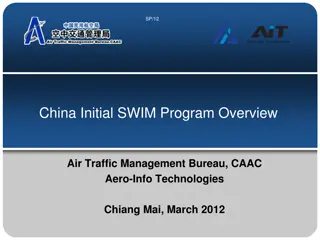Aero Week 7 Update: Progress and Plans
In this week's update, Robbie McNally discusses tasks completed and upcoming plans for the project. Activities include clarifying precision requirements, securing funding, testing equipment, and researching batteries. The focus is on optimizing System 1 (Optimus Prime) and System 2 (Batman Seagull Wireless Dashboard Flight System). Next week's agenda involves battery and power calculations, servo current drain assessment, and component ordering for the project. Stay tuned for further developments!
Uploaded on Mar 12, 2025 | 0 Views
Download Presentation

Please find below an Image/Link to download the presentation.
The content on the website is provided AS IS for your information and personal use only. It may not be sold, licensed, or shared on other websites without obtaining consent from the author.If you encounter any issues during the download, it is possible that the publisher has removed the file from their server.
You are allowed to download the files provided on this website for personal or commercial use, subject to the condition that they are used lawfully. All files are the property of their respective owners.
The content on the website is provided AS IS for your information and personal use only. It may not be sold, licensed, or shared on other websites without obtaining consent from the author.
E N D
Presentation Transcript
Aero Week 7 Robbie McNally
What I did... -Talked to Russo Clarified DAS precision requirements -Submitted EcE department funding letter -Setup time for Radio Link Budget meeting with Professor Hedrick -Received SD Cards -Camera Testing -Designed an alternate/backup system -Started calculating data rate for transmitter/receiver in system 1 -Researched LiPO batteries for way too long
System 2: Batman Seagull Wireless Dashboard Flight System $369.99
Seagull Wireless Dashboard Flight System $369.99 900 MHz, 200mW (US FCC Approved, up to 1.2 Miles Range with included Wire Antennas) The Seagull Telemetry system has 3 main components: Seagull Dashboard Telemetry Receiver - this unit displays telemetry data, and sounds alarms when problems occur. Onboard Flight Data Recorder - this unit collects the data from built-in and external sensors. Onboard Telemetry Transmitter - this unit sends the data from the Recorder to the Dashboard Airspeed from ~9MPH to 290MPH USB Live Mode for real time bench monitoring Altitude to 25,000+ feet Lightweight - approx 1.5 ounces with unit and cables Ultra-low power consumption - around 35 mA Fully compatible with all known flight RC radios no need to replace existing electronics Small self-contained LCD Telemetry receiver attaches simply to controller
Batteries FPV Transmitter: 11.1V-12V | 2s-4s FPV Receiver: 11.1V-12V | 2s-3s Arduino: 5V-12V for barrel jack Servos: ?? What I think we Need: -2 LiPo 3S 11.1V batteries: 1 for plane and 1 for receiver on ground -Low Voltage Cutoff or LiPo Voltage Alarm
Next Week -Battery and power calculations -Servo current drain -DAS power: Tx/Rx, Arduino, Sensors -FPV power: Tx/Rx (separate locations) -Start assembling and coding -Order batteries, charger, and new airspeed sensor if needed -Determine electrical component of drop mechanism to order parts























